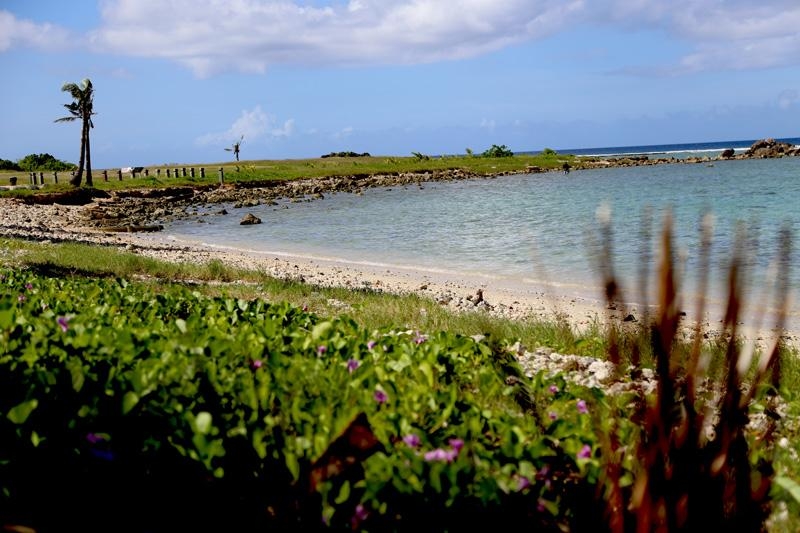
Image credit: Jihan Estrella
Guam is not a popular holiday destination for many Asians. For some, it’s a virtually unknown territory. But did you know that 80% of the population in the country is made up of Japanese tourists? So, let me unpack for you a list of reasons why you should consider Guam your next destination of choice. Get to discover what you’ve been missing out – and what those Japanese tourists have been enjoying – all along.
1. Guam is a quick plane ride from Southeast Asia

View from Fort Soledad | Image credit: Jihan Estrella
Guam is the largest of the Mariana Islands and is a territory of the United States in the western Pacific Ocean. The island’s capital is Hagåtña (formerly named Agana) and is served by the Antonio B. Won Pat International Airport. Being a hub for United Airlines, this is frequently the layover stop for flights bound to North America. There is a Philippine Airlines direct flight from Manila to Guam which only takes three hours and costs around PHP 16,000-18,000 (US$310-350) for a two-way trip. The airline ticket price is not bad because it is comparable to a flight to elsewhere in Asia. The island, however, is a US-territory so if your nationality requires one, make sure that your not-yet-expiring US Visa is well on-hand.
2. It has affordable three to five-star hotels

Hotel Nikko Guam | Image credit: Jihan Estrella
There are a number of three to five-star hotels with beautiful beach fronts around the island. Most of the well-known hotels lining Tumon Bay and Tamuning are Hotel Nikko Guam, Hilton Guam Resort, Fiesta Resort, Sheraton Laguna Guam Resort, The Westin Resort Guam, and Hyatt Regency Guam. These are not your typical budget hotels since they are well-known hotel chains. Prices per night vary from US$100-150. As expected from American hotels, the rooms are very spacious. For our October trip (which was off-season, so discounts could be availed!), we settled in Hotel Nikko Guam, which was very near a beach bar. We were told that the beach bar was often frequented by military personnel. If you like men in uniform, then this could be your chance to snatch an eye candy.
3. Convenient (and free) public transportation are available

Tumon Shuttle | Image credit: Jihan Estrella
Surprisingly, getting around Guam is easier and cheaper than going around Hong Kong or Singapore. Guam is spared from the octopus-like train system of the former two countries. Most Japanese tourists prefer renting cars – which I believe is the best way to get around Guam and go beach-hopping.
Here are the available transportation in Guam.
Taxi: The flag down rate is around US$6. It would be cheaper to take the bigger taxis if there are 5-6 people in your group because the fare for shuttle buses is US$3 per person. Also, nothing is too far from one point to another in Guam. Miki Taxi has a promotion in which passengers can ride for free going to and from Duty Free Shopping (DFS) Guam.
Shuttle Buses: A bus ticket costs US$3 per person per day and has discounted prices when buying a week’s ride. The shopping mall buses that I’d recommend taking are the (1) mermaid-adorned white Sirena Bus Line because it services the shopping mall route; (2) the red Tumon Shuttle because it provides free rides going to and from the Guam Premier Outlet and stops at almost all the hotels; and the (3) DFS Galleria Shuttle Bus because it gives free rides to hotel guests going to DFS Galleria.
4. It is a duty-free shopping heaven

Luxury brands to shop from | Image credit: Jihan Estrella
I’ve heard rumours that Guam is one big shopping paradise and I’ve proven this to be true as prices are indeed really low for US-based brands. I was able to buy a Levis Jeans at Macy’s (which is not a duty-free shop, mind you) for only US$20. You’d also be able to score a haul of makeup items from Benefit for a total of only US$60 at DFS Galleria Guam. Bags and shoes from Michael Kors, Calvin Klein and Lacoste would only cost from US$12-30. Luxury brands like Louis Vuitton, Gucci and Bally were said to be relatively cheaper too. Some of the people in my group purchased bags, belts and shoes that were 40-60% cheaper than the retail prices in the US. It would be good to know that Macy’s (located inside Micronesia Mall) have up to 70% off every Thursdays. Meanwhile, new stocks at outlet stores are available every Tuesday and they open at 8.30am.
5. Visitors can go beach-hopping

Image credit: Jihan Estrella
One thing I would highly recommend doing on the island is beach hopping. Get a rental and stop at every beach you see because they are just amazing. When we had an island tour (which only lasted for four hours), I wanted to jump out of the car because the clear aquamarine water was just so inviting. If privacy is important to you then you’d be glad to know that I saw only two sunburned tourists and a group of Japanese high school students photo-tripping at the beaches. It’s a great recommendation for a solitary and relaxing vacation.

Two Lovers’ Point | Image credit: Jihan Estrella
A personal favourite is the Gun Beach and Two Lovers’ Point. It was said that a lot of Japanese couples like to get married in Guam – and the Two Lovers’ Point is one of their most favourite places to get married in. Maybe it’s because of the romantic legend (albeit, a tragedy) surrounding the place.
6. There are virtually no crimes and no traffic jams

Get a rental and drive along the scenic route | Image credit: Jihan Estrella
The island is so small that it would be a wonder for someone to get lost. A local fondly told me that if someone committed a crime in the morning, the culprit would be caught by the end of the day because there’s nowhere to run. A traffic jam, on the other hand, was defined by locals as stepping on the breaks for a few minutes.
7. Because… submarine expeditions!

Fort Soledad | Image credit: Jihan Estrella
Need I say more? Where else can you admire the beautiful coral reef from inside a real submarine? This attraction, which is very popular with locals and tourists and was known to sell out fast, takes you to a depth of 20 to 40 metres underwater. It really is quite an experience. Check out Atlantis Guam if you’d want to avail of this unique underwater adventure.

Amazing view of the city | Image credit: Jihan Estrella
If those reasons weren’t enough for you to visit Guam, then how about noting the Insta-worthy and historically fascinating colonial-style architecture around the island and the ethereal views of the ocean from Fort Soledad and Magellan’s Landing? I bet you’ll be saying “Hafa Adai” (pronounced HALF A DAY), which means “Hello” in Chamorro, the native language of Guam, this coming summer.







